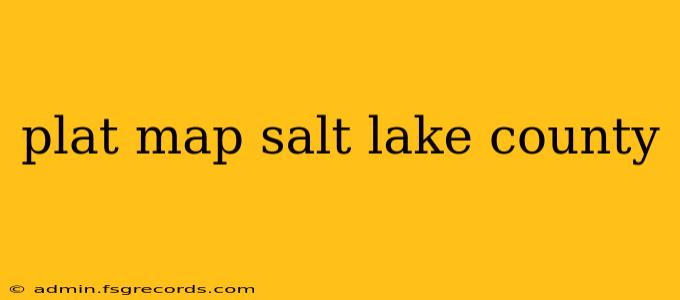Finding the right Salt Lake County plat map can feel like navigating a maze. This comprehensive guide will demystify the process, equipping you with the knowledge and resources to locate the precise plat map you need, whether you're a homeowner, real estate professional, or researcher. We'll explore various resources, explain the information contained within these maps, and provide tips for efficient searching.
Understanding Salt Lake County Plat Maps
Plat maps are detailed, scaled drawings that illustrate the boundaries of individual lots within a specific subdivision or area. These aren't just simple diagrams; they're legal documents that define property lines, lot numbers, street names, easements, and other crucial details. In Salt Lake County, these maps are essential for various reasons:
- Property Research: Determining property boundaries, lot size, and potential easements.
- Real Estate Transactions: Verifying property details during buying or selling processes.
- Construction and Development: Planning new construction projects and ensuring compliance with zoning regulations.
- Legal Disputes: Resolving boundary disputes or other legal matters related to property ownership.
- Historical Research: Tracing property ownership and development patterns over time.
Locating Salt Lake County Plat Maps: Your Step-by-Step Guide
Accessing Salt Lake County plat maps can be achieved through several avenues:
1. Salt Lake County Recorder's Office (Primary Source):
This is the most reliable source for official plat maps. The Recorder's Office maintains a comprehensive archive of plat maps, both physical and digital. While they may not offer online browsing of every map, their website will likely provide contact information and instructions on how to request specific maps, either in person, by mail, or potentially through a fee-based online access system.
2. Online Mapping Services (Secondary Sources):
Several online mapping services might provide access to Salt Lake County plat maps, though the level of detail and accuracy can vary. Always verify information found on these services against official records from the County Recorder's Office. Look for services that specialize in property records and plat maps; they may offer search functionality by address, lot number, or subdivision name.
3. Third-Party Data Providers:
Some companies specialize in providing access to property data, including plat maps. These services often charge a fee but might offer convenient online access and advanced search capabilities. Ensure you choose a reputable provider with a proven track record.
Deciphering Plat Map Information: Key Elements to Identify
Once you've obtained a plat map, understanding its components is vital. Key elements include:
- Lot Numbers: Unique identifiers for each individual parcel of land.
- Block Numbers: Groups of lots within a subdivision.
- Street Names: Clearly labeled streets and roads within the platted area.
- Easements: Areas designated for utilities, access, or other shared uses.
- Boundaries: Precisely drawn property lines defining the limits of each lot.
- Monumentation: Locations of survey markers or other physical reference points.
- Scale: Indicates the ratio between the map's dimensions and the actual ground measurements.
Tips for Successful Plat Map Searches:
- Start with a known address or lot number: This provides a specific starting point for your search.
- Be precise with your search criteria: Use the correct spelling of street names and subdivision names.
- Consult multiple resources: Compare information from different sources to ensure accuracy.
- Understand limitations: Online map services might not have the most up-to-date information. Always rely on the official records from the Salt Lake County Recorder's Office for legal purposes.
By following this guide, you'll be well-equipped to navigate the world of Salt Lake County plat maps and find the precise information you need. Remember that official records from the County Recorder's Office are always the most reliable source.

